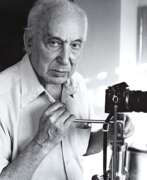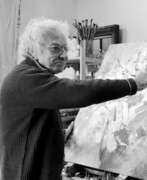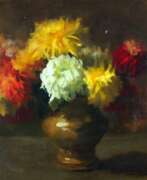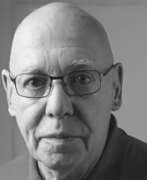Flower still life Contemporary art


Frederico Aguilar Alcuaz is a Filipino abstract painter, sculptor and ceramist, and master tapestry artist.
He studied painting at the University of the Philippines' School of Fine Arts, then lived and worked both in the Philippines and Spain, and in Brno, Czech Republic, he worked extensively on tapestries.
Alcuaz has earned international acclaim with his vivid abstract works in various genres and techniques, and he has exhibited extensively internationally.


Armando, born Herman Dirk van Dodeweerd, was a Dutch painter, sculptor, poet, writer, violinist, actor, journalist, film, television and theater maker. Armando was his official name; his birth name, the pseudonym as he called it, no longer existed for him. He himself saw his work as «Gesamtkunstwerk», based on his experiences from the Second World War in the vicinity of Kamp Amersfoort.


Ugo Attardi was an Italian painter, sculptor and writer. Attardi moved from Genoa to Rome in the early 1950s, where he formed the group Forma 1 together with other artists. His sculpture of Ulysses is now permanently installed in Battery Park in New York


Virginia Berresford is an American artist and printmaker.
Virginia Berresford studied with George Bridgman at the Art Students' League and in Paris with Amedee Ozenfan from 1925 to 1930. Berresford was known for her landscape paintings with strong composition and use of colour as well as attention to detail.
In the 1950s she opened an art gallery in Edgartown, Martha's Vineyard. Her work is included in the permanent collections of the Whitney Museum of American Art, the Detroit Art Institute and the Dallas Museum of Art.


Armin Boehm is a German artist who lives and works in Berlin.
In his works, Boehm explores the connections between the urban and natural environments of modern man. He creates a fantastic urban space filled with cyborgs, politicians and flowers. In the collage technique the artist combines fragments of color, fabric, paper or metal substances from which his paintings grow. He mixes elements of pop culture and art history, architecture and literature, contemporary politics and fantasy.


Cornelius Bosch is a South African expressionist painter known for his figurative works created in various techniques, including painting, drawing and sculpture. Bosch was educated at Stellenbosch University and began his artistic career in the 1980s. Bosch's paintings are characterised by a bold use of colour and dynamic composition, often with geometric shapes and brushwork gestures. Throughout his career he exhibited widely both in South Africa and abroad, and his works are held in several public collections, including the South African National Gallery of Iziko and the Johannesburg Art Gallery.


Peter Chevalier is a German painter whose paintings and drawings are close to surrealism. In the 1980s, Chevalier juxtaposed the realistic with the abstract in his paintings. Clearly configured individual but combined things (houses, airplanes, stumps of columns, light bulbs, bones, etc.) dominated, which – as if one were cutting out illustrations from magazines and reassembling them as a collage – are inconsistent in their proportions in the pictorial context.


Natalia Edenmont (Russian: Наталия Эденмонт), born Natalie Nicole Edenmont (Натали Николь Эденмонт), a Swedish-Ukrainian photo-based artist, has been carving a unique niche in the world of art since her move to Sweden from Yalta, Crimea, in 1991. Born in 1970, Edenmont's journey in art began with her studies at the State Art School of Kiev and continued at Simferopol State Art School in Crimea. Her talent and passion for art took a new direction at Forsberg’s International School of Design in Stockholm, Sweden, where she studied graphic design.
Nathalia Edenmont's work is a reflection of her personal experiences and inner visions. She is renowned for her distinctive approach to creating art, which involves visualizing the images in her mind in their entirety before capturing them. This meticulous process is evident in her stunning portraits of women adorned in dresses made of fruits, flowers, and even shimmering beetles, showcasing a blend of the natural and the fantastical.
Her portfolio is diverse, including the use of dead animals and animal parts in her photographs, a practice that might be controversial but is deeply symbolic. These creations are more than just visual spectacles; they are narratives of life, death, and the unspoken stories of nature.
Nathalia Edenmont's art has gained international recognition, with exhibitions held in prominent cities like London, New York, Berlin, and Moscow. Her works have found a place in both private and public collections globally, including esteemed institutions such as the Modern Museum in Stockholm, the Miami Art Museum, and the Moscow House of Photography Museum.
For collectors and art experts, Nathalia Edenmont’s works offer a glimpse into a world where art intersects with personal experience, nature, and introspection. Her unique vision and masterful execution make her pieces a valuable addition to any collection that seeks depth and a touch of the surreal.
If you are an enthusiast or collector of contemporary art and wish to stay updated on Nathalia Edenmont’s works, exhibitions, and sales, consider signing up for updates. This subscription will keep you informed about new opportunities to explore and acquire pieces from this remarkable artist's collection.


Janet Fish is a contemporary American realist artist. Through oil painting, lithography, and screenprinting, she explores the interaction of light with everyday objects in the still life genre. Many of her paintings include elements of transparency (plastic wrap, water), reflected light, and multiple overlapping patterns depicted in bold, high color values. She has been credited with revitalizing the still life genre.


Alfred Fritzsching is a German artist known as Painter, graphic artist, draftsman, sculptor, commercial, commercial graphic artist. He began his training as a commercial graphic artist at the Blocherer School for Graphic and Advertising in Munich and worked as an advertising specialist. In 1970 Alfred Fritzsching became a member of Munich Artists 'cooperative and participated in exhibitions at the Haus der Kunst in Munich. From 1978, he worked as a freelance painter and also as board member and juror of the Munich Artists' Cooperative.


Klaus Fußmann is a contemporary German painter. He studied from 1957 to 1961 at the Folkwang University of the Arts in Essen and from 1962 to 1966 at the Berlin University of the Arts. From 1974 to 2005, he was a professor at the Berlin University of the Arts. His work has won several awards, such as the Villa Romana prize in 1972 and the Art Award of Darmstadt in 1979. Major presentations of his work include exhibitions at the Neue Nationalgalerie in Berlin, 1972; the Mathildenhöhe in Darmstadt, 1982; the Kunsthalle Emden, 1988; the Kunsthalle Bremen, 1992; and the Museum Ostwall in Dortmund, 2003. In 2005 Fußmann completed a monumental ceiling painting in the Mirror Hall of the Museum für Kunst und Gewerbe Hamburg.


Azat Khaizovich Galimov is a contemporary Russian artist. Graduated from the Leningrad Higher School of Industrial Art named after V. Mukhina. Currently lives and works in St. Petersburg, a member of the Union of Artists of Russia, a member of the Petrovsky Academy of Sciences and Arts, a member of the Bulgarian Union of Artists. In 2007 he was included in the catalog "The Best Artists of Russia". An adherent of the realistic school of painting. Lots and lots of work. Makes numerous sketches and writes studies, traveling to different countries. He is especially good at urban landscapes. His works are in museums and private collections in different countries.


Ori Gersht is an Israeli photographer and video artist. He is known for his use of photography and video to explore themes of memory, history, and conflict.
Gersht's work often involves the use of slow-motion and high-speed video, which allows him to capture the ephemeral and fleeting moments that are often overlooked in daily life. He also uses a range of photographic techniques, including still life and landscape photography, to create images that are both beautiful and haunting.
Some of Gersht's most famous series include "Time After Time," which captures the moment of a bursting flower, and "Liquidation," which explores the destruction of historical objects. He has also created video installations that examine the history and memory of the Holocaust.
Gersht's work has been exhibited in major museums and galleries around the world, and he has received numerous awards and honors for his contributions to the field of photography and video art. He continues to produce new work and is widely regarded as one of the most important contemporary artists working today.


Piero Gilardi is an Italian painter and decorator. A catalytic figure in the Arte Povera movement centred in Turin in the late 1960s, Gilardi's utopian and selfless commitment to the association of neo-avant-garde artists from Western Europe and North America made him one of the most influential artistic figures of the period.
Piero Gilardi became internationally renowned and witnessed the influence of Pop Art in Europe. An itinerant artist, theorist and organiser, he contributed to the birth of Arte Povera, especially working to establish relationships with other similar initiatives that were simultaneously taking place outside of Italy.
Much of Gilardi's later work is united by a theme or interaction between the work and the viewer. The master has devoted more than a decade to his most ambitious project, Parco Arte Vivente (Park of Living Art or PAV). A collaborative effort that grew out of Gilardi's design, the PAV is a monumental undertaking that has transformed an abandoned plot of land in the heart of Turin's working-class Lingotto district into a six-acre green space dedicated to public, environmental and artistic interests.


Jürgen Jansen is a German abstract painter who lives and works in Düsseldorf.
Jansen is an experimental, color-intensive painter. He applies multiple layers of transparent colored veils, sprays paint and paints over these layers with a broad brush, forming streams through which flower-like patches of color float like abstract flowers. Looking at Janzen's works inevitably conjures up associations with summer.
Jansen has exhibited his work in numerous solo and group exhibitions in Germany and Belgium.


Wilhelm Kaufmann is an Austrian artist who has been called the master of the moment.
He studied at the Imperial Royal Academy of Fine Arts, then worked as a painter and track and field athlete at the same time. Kaufmann used color dynamics to masterfully depict momentary scenes of athletes' movements during competitions. He also painted colorful still lifes, landscapes and portraits.
Wilhelm Kaufmann was a member of the Professional Association of Austrian Visual Artists, the Sonderbund of Austrian Artists, the Vienna Art Association and the Vienna Hagenbund, the Vienna Secession and the Vienna Society of Artists, Künstlerhaus.


Peter Robert Keil is a German painter and sculptor.
In the beginnings of his artistic career, Peter Keil's style was influenced by German expressionism. However, his style changed visibly at the beginning of the 60s when he lived in Paris for a while and emerged in the city's nightlife. Keil increasingly parted with his realistic approach and developed a new, much more spontaneous and dynamic painting style. Since then, the use of intensive to lurid colours and the absence of realistic representation have become characteristic of his painting style. In his paintings, the colour is applied with quick brushstrokes and occasionally with impasto techniques and the images are additionally abstracted by the use of Graffiti elements. Keil prefers to paint human figures, portraits, big city scenes, landscapes and still life images of flowers. His emotional way of painting is mainly driven by a desire for freedom from social constraints and conventions. In the past 50 years, he has created numerous large- and small scale paintings in oil and mixed media on canvas but also some sculptures in wood and steel and a great number of majolicas.


André Kertész, born Andor Kertész, was a Hungarian-born photographer known for his groundbreaking contributions to photographic composition and the photo essay. In the early years of his career, his then-unorthodox camera angles and style prevented his work from gaining wider recognition. Kertész never felt that he had gained the worldwide recognition he deserved. Today he is considered one of the seminal figures of photojournalism.


Helen Khal was an American artist and critic of Lebanese descent. She started her painting career at the age of 21. She held her first individual exhibition in 1960 in Galerie Alecco Saab in Beirut. Her other one-woman shows took place at Galerie Trois Feuilles d'Or, Beirut (1965); Galerie Manoug, Beirut (1968); at the First National Bank, Allentown, Pennsylvania (1969); in Kaslik, Lebanon (1970); at the Contact Art Gallery, Beirut (1972, 1974 and 1975) and at the Bolivar Gallery in Kingston, Jamaica in 1975. Her work also appeared in the Biennales of Alexandria and São Paulo. She also taught art at the American University of Beirut from 1967 to 1976 and at the Lebanese American University from 1997 to 1980. She inspired many other artists. Helen Khal was also recognized as an author and critic. "From 1966 to 1974, Helen Khal was Art Critic to two Lebanese periodicals, The Daily Star and Monday Morning.


Jean-Marie Lamare is a Flemish primitive painter of today, a rare master of tempera. This technique inherited from the great Flemish Masters surprises with its particular luminosity. The compositions of J. M. Lamare transport us to a fantastic world.


Richard Learoyd is a British photographer. He is known for his large-scale, camera obscura photographs that capture incredibly detailed, lifelike images of people and objects.
Learoyd studied fine art painting before transitioning to photography, and his work often blurs the lines between photography, painting, and sculpture. He constructs his own camera obscura by building a room and attaching a large, convex lens to one wall, which projects an upside-down image of the subject onto a sheet of photographic paper. He then uses traditional darkroom techniques to develop and print the final image.
Learoyd's photographs often feature portraits of friends and family members, as well as still lifes of everyday objects such as fruit, flowers, and animals. His work has been exhibited widely and is included in the collections of many major museums, including the Victoria and Albert Museum in London, the Getty Museum in Los Angeles, and the Museum of Modern Art in New York.
Learoyd has received numerous awards and honors for his photography, including a Guggenheim Fellowship and a commission to create a portrait of Queen Elizabeth II for the Diamond Jubilee of her reign.


Judith Linhares is an American painter, known for her vibrant, expressive figurative and narrative paintings. She synthesizes influences including Expressionism, Bay Area Figuration, Mexican modern art and second-wave feminism, in work that flirts with abstraction and balances visionary personal imagery, expressive intensity, and pictorial rigor. In the early 1970s, Linhares created narrative drawings and assemblages that appropriated commonplace or "craft" materials and feminine imagery (flowers, eggs, swan feathers, domestic scenes). After 1980 she developed a Symbolist allegorical world of enigmatic, bulbous-headed creatures, narcoleptic nudes, phantasms, figures in boats, and human metamorphosis. Her fantastic imagery was balanced by lush color, painterly sensual surfaces, and sure design. Through the 1990s, critics noted in her work a sunnier palette, increasingly abstract and ambiguous imagery, and a growing facility with a naïve drawing style. In the 2000s, Linhares has turned to female nudes (often monumental), visionary landscapes, floral still lifes and animals. Linhares has been recognized with more than forty-five one-person exhibitions and major awards from the American Academy of Arts and Letters and John Simon Guggenheim Memorial Foundation.


Andrew Mansfield is a British Painter, born in Leicester, who studied at Loughborough College of Art and Design, 1970-3, and Portsmouth Polytechnic, 1976-9. In 1987 he was an artist-in-residence in Lisbon. His solo shows included Spacex Gallery, Exeter, 1984; Winchester Gallery in Winchester, 1985; Midland Group, Nottingham, the same year; and Anthony Reynolds, 1986.


Alferio Maugeri is a French artist. In his youth, he was engaged in the restoration of churches in the footsteps of Michelangelo and the masters of the Renaissance. During this period, he developed the art of decoy, the ability to create artificial marble, gilding and improve religious frescoes. Alferio Mogeri is a member of the Paris Association of Arts, Sciences and Letters and his work is recognized throughout the world. The paintings were exhibited in Milan, New York, Geneva, Osaka, Tokyo and had magnetism and charm.


Vera Mercer is a German-born photographer who lives and works in France and the United States.
In the early 1960s she became part of the artistic avant-garde in Paris, which later became known as the "New Realists" (Nouveau Réaliste), photographing movie stars and avant-garde artists of the time. Later she found a new inspiration.
Mercer creates extraordinary large-scale photographic still lifes of food. With the right lighting and carefully chosen compositions of china, cutlery, fruit, seafood and game, Mercer's photographs resemble still lifes in the Dutch Baroque style. With burning candles and artful arrangements, the paintings, flooded with mystical light, are also a reinterpretation of classic vanitas motifs.


Hermann Naumann, a distinguished German artist, has made significant contributions to the fields of painting, graphics, illustration, and sculpture. Starting his artistic journey with a stonemasonry apprenticeship, Hermann Naumann later honed his skills in sculpture under the guidance of Burkhart Ebe and Herbert Volwahsen at the HBK Dresden. Over time, he expanded his artistic repertoire to include painting and graphic arts, embracing techniques like lithography, etching, and punch cutting.
Hermann Naumann's works are celebrated for their depth and versatility, reflecting his mastery over various mediums. Notably, his illustrations for literary works, such as Heinrich Böll's "Erzählungen" and Franz Kafka's "Betrachtung," showcase his exceptional ability to complement and elevate textual narratives through visual art. His public sculptures, like the relief in Dresden and the "Fahnenschwinger" in Riesa, further attest to his prowess in creating engaging and meaningful art.
For art collectors and enthusiasts, Hermann Naumann's oeuvre offers a rich tapestry of visual narratives, each piece echoing the artist's profound engagement with his subjects and mediums. Those interested in exploring Hermann Naumann's artistic journey and his contributions to German art and culture are encouraged to stay updated on exhibitions, sales, and auctions featuring his work.


Hans Joachim Pietrula is a German painter, graphic artist and sculptor living in Alsace.
In his watercolors and oil paintings, collages, chalk and glass works, wood and stone engravings and sculptures, Pietrula's decades of creative work never tires of revealing his almost loving admiration for nature and his gentle observation of people. Pietrula loves life, admires nature and celebrates sensuality with vivid colors.


Peter Schmersal is a German painter who lives and works in his native city and in Berlin. His work is characterized by a stylistic variety. Schmersal studied graphic design in Wuppertal from 1971 to 1975 and then worked as a graphic designer. From 1978 he engaged in painting. In the mid-1980s, primarily still lifes, landscapes and architectural depictions were created. There is already a certain casualness to the motifs from this period, they appear in fleeting snapshots that are characterized by a fragmentary execution. The still lifes show classic subjects: flowers, fruits, dead animals and everyday objects such as bottles, serviettes, stools or tables. At the beginning of the 1990s, in addition to urban landscapes, there were above all examinations of the portrait, which is also often fragmented, not only from the front, but often also in an unusual top or bottom view, up to a physiognomic detail representation, for example the mouth and mouth eye area. Since the beginning of the millennium, the choice of motifs at Schmersal could hardly have been more heterogeneous. Due to the well-considered incoherence of individual motifs, Schmersal juxtaposes the most diverse types of authorship, style, genre and context of exploitation. In terms of motifs, there are still no self-imposed specific guidelines, but figures, still lifes and landscapes continue to dominate




Dorothea Schrade is a German artist and gallerist.
Schrade studied at the Academy of Fine Arts in Stuttgart, since 1973 she has been actively engaged in the gallery business and has founded several art schools and galleries.
Dorothea Schrade's painting is characterized by three main themes: large poppy flowers, in which the artist sees a symbol of life and death; landscapes with their various shades of green; and finally, various livestock, particularly cows in the pasture.


Carlotta Stocker is a Swiss expressionist artist, interior designer and illustrator. She is especially known for her large-scale interpretations of the studio table, in which she worked with strong colors. She developed an expressive, emotional and colorful style for her works. Stocker also created large-format murals in public buildings in Zurich.


Egon Arnold Alexis Freiherr von Vietinghoff was a German-Swiss painter, author, philosopher and creator of the Egon von Vietinghoff Foundation. He reconstructed the lost painting techniques of the Old Masters, and created some 2,700 paintings.
The immense work of Egon von Vietinghoff includes all classical motifs: flowers, still lifes, landscapes, portraits, nudes, and figural scenes. Due to the large demand, more than half of his total work consists of fruit still lifes. The beholder's normal distance to the picture procures balanced representation and self-contained calm of the object. Without losing himself in details, Vietinghoff leads the eye through the whole spectrum of nuances of color and finds the balance between intensity and gentle peace. Thus, he created the impression of unity and harmonic interaction of object and background, light and shadow, form and color, detail and totality.




Gesa Will is a contemporary German artist. 1965-1969 studied painting and graphics in Cologne and Munich. She undertook study trips to France, Spain, Morocco, Turkey, Iran, Afghanistan and Pakistan. Since 1970 she has been working as a freelance artist. Has his own graphic design studio in Munich. She paints plants, landscapes, still lifes, portraits.

























































